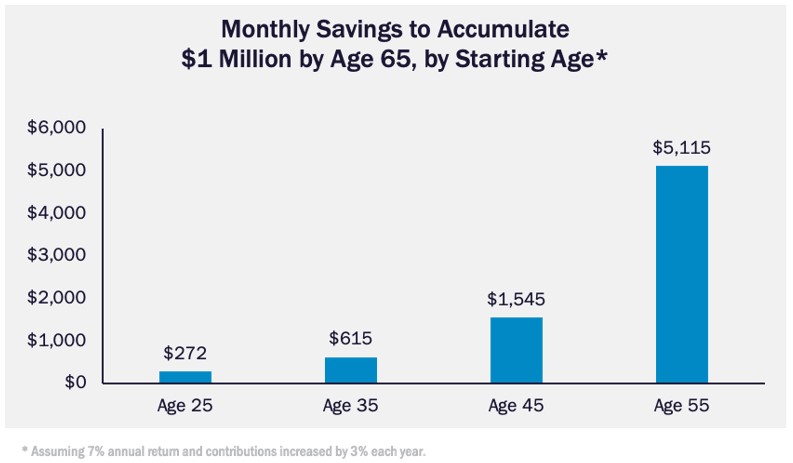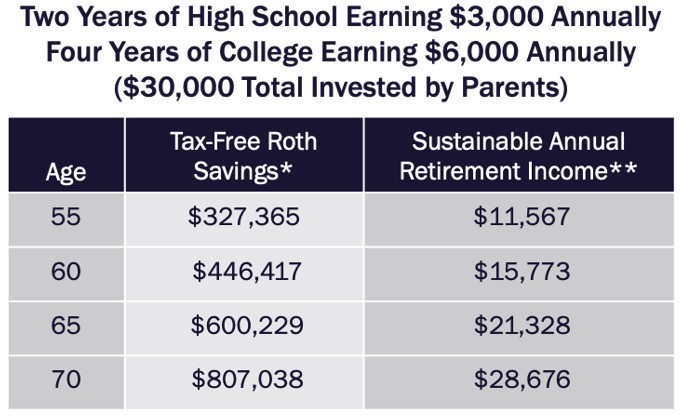How to Jump-Start Your Kids’ Retirement Savings
Helping your kids fund a Roth IRA can both get them started early on saving for retirement and show them the importance of saving early and often.


I want to share a strategy that can help your children get a huge jump start on their retirement. Many clients I work with wish they’d started saving at a much younger age, and they worry their children may make the same mistakes. So, many of them hope to teach their children how to manage their own money.
One of the most important lessons to teach is how important it is to save. Most people don’t realize how much they need to save for retirement. For instance, using a common 4% sustainable withdrawal rate in retirement, you’d need to save $1 million by retirement in order to have $40,000 of sustainable annual income in retirement.
That savings goal can feel pretty daunting, especially for younger people. But the biggest advantage young people have when it comes to retirement is that they have a lot of time for their savings to grow. The earlier they start saving and investing, the more wealth they’ll build.
From just $107.88 $24.99 for Kiplinger Personal Finance
Become a smarter, better informed investor. Subscribe from just $107.88 $24.99, plus get up to 4 Special Issues

Sign up for Kiplinger’s Free Newsletters
Profit and prosper with the best of expert advice on investing, taxes, retirement, personal finance and more - straight to your e-mail.
Profit and prosper with the best of expert advice - straight to your e-mail.

But let’s get real… I’ve yet to meet the teen who is thinking about their retirement. A simple strategy that parents can implement to jump start their children’s retirement savings is to help them fund a Roth IRA.
Say your kid earns $3,000 from a job in 2023. If the income is W-2, they can contribute 100% of their earned income up to $6,500 to a Roth IRA, or $3,000. If income is 1099, the contribution limit is reduced by 7.65% (half of the self-employment tax) or $229.50 and can contribute $2,770.50 to the Roth IRA.
They probably won’t have the cash to make contributions themselves (even if they wanted to), but this is where parents can step in by giving them a tax-free cash gift (up to $17,000 per person for 2023) that can be used to fund the Roth IRA. In most states, if the child is a minor, you’d have to start with a minor Roth IRA where the parent is the custodian of the account, and then you can convert the account to a regular Roth IRA owned by the child once they are legally an adult.
How big an impact can this have on your kids’ lives? Assume they contribute $3,000 a year as a high school junior and senior, and $6,000 a year during all four years of college (so $30,000 in total contributions). If they earn a 6.8% annual return from ages 16 to 40, 6.4% from ages 41 to 60 and 6.1% after age 60 (the expected returns from 80% stock, 70% stock and 60% stock allocations, respectively), they’d have more than $600,000 of tax-free retirement savings by age 65, which could yield more than $21,000 of sustainable tax-free income throughout retirement.

* For simplicity, invested accounts assume following: 80% stock allocation from ages 16 to 40 earning 6.8% annually net of fees, 70% stock allocation from ages 41-60 earning 6.4% annually net of fees, 60% stock allocation after age 60 earning 6.1% annually net of fees. All numbers shown are in future dollars and net of 1% advisory fee. ** Sustainable annual retirement income assumes 4% annual withdrawal rate.
In addition, this creates an opportunity to teach your kids some basic investing concepts, such as what retirement accounts are and the time value of money. Hopefully, they’ll become accustomed to the annual contributions and carry those good habits forward into their adult lives.
That’s a legacy you can be proud of.
related content
- 2 Ways Retirees Can Defuse a Tax Bomb (It’s Not Too Late!)
- Will Your Kids Inherit a Tax Bomb from You?
- Four Ways Parents Can Help Kids Be First-Time Home Buyers
- Leaving an Inheritance? Is It Better to Give to Kids Now or Later?
- Should You Help Out Your Adult Kids Financially?
Profit and prosper with the best of Kiplinger's advice on investing, taxes, retirement, personal finance and much more. Delivered daily. Enter your email in the box and click Sign Me Up.

David McClellan is a partner with Forum Financial Management, LP, a Registered Investment Adviser that manages more than $7 billion in client assets. He is also VP and Head of Wealth Management Solutions at AiVante, a technology company that uses artificial intelligence to predict lifetime medical expenses. Previously David spent nearly 15 years in executive roles with Morningstar (where he designed retirement income planning software) and Pershing. David is based in Austin, Texas, but works with clients nationwide. His practice focuses on financial life coaching and retirement planning. He frequently helps clients assess and defuse retirement tax bombs.
-
 HNW Retirees: Don't Overlook The Benefits of Social Security
HNW Retirees: Don't Overlook The Benefits of Social SecurityWealthy retirees often overlook Social Security. But timed properly, it can drive tax efficiency, keep Medicare costs in check and strengthen your legacy.
-
 Do You Have an Insurance Coverage Gap for Your Valuables?
Do You Have an Insurance Coverage Gap for Your Valuables?Standard homeowners insurance usually has strict limits on high-value items, so you should formally "schedule" these valuable possessions with your insurer.
-
 What to Do If You Plan to Make Catch-Up Contributions in 2026
What to Do If You Plan to Make Catch-Up Contributions in 2026Under new rules, you may lose an up-front deduction but gain tax-free income once you retire.
-
 High-Net-Worth Retirees: Don't Overlook These Benefits of Social Security
High-Net-Worth Retirees: Don't Overlook These Benefits of Social SecurityWealthy retirees often overlook Social Security. But timed properly, it can drive tax efficiency, keep Medicare costs in check and strengthen your legacy.
-
 Do You Have an Insurance Coverage Gap for Your Valuables? You May Be Surprised to Learn You Do
Do You Have an Insurance Coverage Gap for Your Valuables? You May Be Surprised to Learn You DoStandard homeowners insurance usually has strict limits on high-value items, so you should formally "schedule" these valuable possessions with your insurer.
-
 8 Practical Ways to Declutter Your Life in 2026: A Retirement 'Non-Resolution' Checklist
8 Practical Ways to Declutter Your Life in 2026: A Retirement 'Non-Resolution' ChecklistHere's how to stop wasting your energy on things that don't enhance your new chapter and focus on the things that do.
-
 To Retire Rich, Stop Chasing Huge Returns and Do This Instead, Courtesy of a Financial Planner
To Retire Rich, Stop Chasing Huge Returns and Do This Instead, Courtesy of a Financial PlannerSaving a large percentage of your income, minimizing taxes and keeping spending in check can offer a more realistic path to retiring rich.
-
 New Year, New Retirement Rules: Here's How You Can Keep Up as the Landscape Changes
New Year, New Retirement Rules: Here's How You Can Keep Up as the Landscape ChangesFor a successful modern retirement, prepare for a longer life, manage high health care costs and prioritize your social life and purpose.
-
 7 Creative Ways to Spend Less and Save More In Retirement, Courtesy of a Financial Pro
7 Creative Ways to Spend Less and Save More In Retirement, Courtesy of a Financial ProWorried you won't have enough money later in life? Try redesigning your vision of retirement, and you may find your savings go further than you thought.
-
 I'm an Annuities Pro: This Is How You Can Cover the Income Gap While Your Social Security Benefits Grow
I'm an Annuities Pro: This Is How You Can Cover the Income Gap While Your Social Security Benefits GrowTaking Social Security later results in higher future income, but that can create an income gap. Annuities can boost income until you file for benefits.
-
 I'm a Financial Pro: You Really Can Make New Year's Money Resolutions That Stick (and Just Smile as Quitter's Day Goes By)
I'm a Financial Pro: You Really Can Make New Year's Money Resolutions That Stick (and Just Smile as Quitter's Day Goes By)The secret to keeping your New Year's financial resolutions? Just make your savings and retirement contributions 100% automatic.